|
| |
Water and Sanitation
Health Basics: A supplement to Issue no. 31 - December 1987
pdf
 version of
this Issue version of
this Issue
|
There is much information in this issue that is valuable
and useful. Online readers are reminded, however, that treatment guidelines and health
care practices change over time. If you are in doubt, please refer to
WHO's up-to-date Dehydration Treatment
Plans.
|
Pages 1-6 Water and Sanitation
A supplement to Dialogue on Diarrhoea Online Issue 31
- December 1987
|
DDOnline Water
and Sanitation supplement to DD31  Page 1 2
Page 1 2
HEALTH BASICS: WATER AND SANITATION
Health workers are aware of the link between safe water supplies and excreta disposal
and the prevention of diarrhoeal diseases, but the installation of these facilities only
provides half the answer. Of equal importance is teaching people how to use them. When is
handwashing most important? How do you maintain safe water supplies? This insert provides
practical information on hygiene behaviour at family and community level before, during
and after the . installation of water and sanitation facilities. SAFE WATER To be sure that the water we use for drinking is safe, contamination must be prevented:
- At the water source and in the water delivery system (wells, pipes, taps etc).
- Between collection and use.
Safe water from wells To protect well water from contamination you can:
- construct a wall around the well with a platform and drainage facilities. This will help
to prevent soil from falling into the well and waste water from draining back into it;
- only use one bucket to draw water from the well and keep this bucket clean;
- if possible, keep the well covered when it is not being used;
- take care that the rope of the bucket cannot get dirty with soil and contaminate the
water;
- make sure that your hands are clean when using the bucket;
- bathe, and wash clothes, away from the well so that waste water cannot drain back into
the well;
- keep surroundings clean and animals away from the well.
|
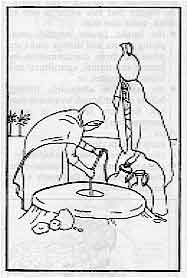 |
These points are also equally important for wells where handpumps are used to lift the
water instead of buckets. Handpumps need to be properly operated and maintained to
guarantee a permanent supply of safe water.
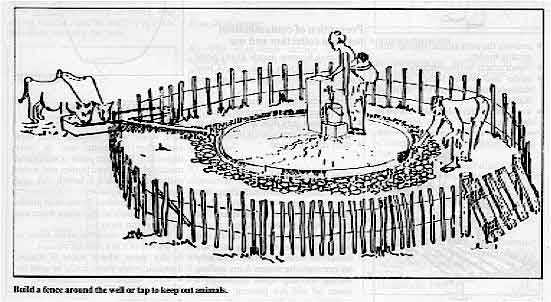
Build a fence around the well or tap to keep out animals.
|
|
DDOnline Water
and Sanitation supplement to DD31  1 Page 2 3 1 Page 2 3
Safe water from public taps Tap water can be from a spring water, groundwater or surface water source. To ensure
that this water is safe to drink, make sure that:
- the intake (water source) area, piping system and storage tanks are protected from
contamination by human and animal, agricultural and industrial wastes; or
- the water is adequately treated before use (although treatment may not be very feasible
in some communities).
Also:
- keep the taps clean;
- clean the area around the tap daily;
- clean (and unblock if necessary) the drains' regularly so that waste water can drain
away;
- prevent the area around the tap from getting muddy;
- repair cracks in the concrete;
|
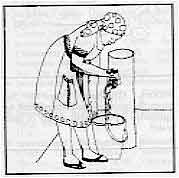
|
- bathe and wash clothes at some distance away from the drinking water tap;
- keep cattle and other animals away from taps
|
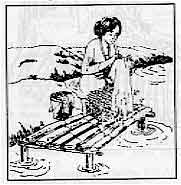 |
Other ways to stop water from being contaminated include:
- asking a person living near the tap to look after it;
- building special facilities at some distance away from the water source for bathing and
washing clothes;
- making a fence around the tap to keep out animals;
- building special ditches or troughs away from the tap for cattle and domestic animals to
drink from.
Prevention of contamination between collection and use
|
Water may become unsafe at any
point between collection and use. Clean water can easily become contaminated when:
- it is touched by dirty fingers;
- it is poured into a dirty container;
- dirt or dust gets into the water from the air if the container is uncovered;
- dirty cups are used.
|
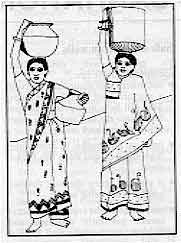 |
Points to remember:
- wash hands before collecting and carrying water;
- make sure the container for collecting the water is clean;
- carry water in a covered container if it has a large opening (e. g. if it is a bucket or
basin). This will also help to prevent the water from spilling during the trip home
(although a loose lid will not prevent spilling) and make sure the cover is clean;
- if possible, empty and clean the household water storage container daily;
- keep household water storage containers covered, and do not allow children or animals to
drink from them;
- allow no one, especially a child, to put their hands into the storage container;
- pour water out of the water storage container without touching it, or use a clean
long-handled dipper to take the water out;
- use clean cups or mugs for drawing and drinking the water.
|
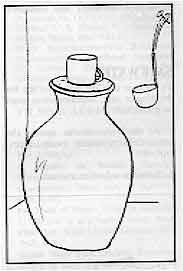 |
SAFE WASTE WATER DISPOSAL
Safe waste water disposal from taps and after domestic use is very important. Stagnant
pools of water and muddy places around houses and water collection sites are a health risk
and can attract mosquitoes.
- clean and unblock drains near public taps regularly so that waste water can always run
away;
- throw away domestic water waste or dispose of it in a soakage pit.
In dry areas where water is scarce, domestic waste water could be used to:
- water vegetables and fruit trees;
- water domestic animals;
- clean latrines.
|
|
DDOnline Water
and Sanitation supplement to DD31  2 Page 3 4 2 Page 3 4
PERSONAL HYGIENE
|
Handwashing can help to reduce the risk of disease transmission.
Good personal hygiene can prevent or reduce the incidence of diarrhoea, skin and eye
diseases and body lice. One way to improve personal hygiene is to have plenty of water
near people's homes. This can be used for:
- washing hands after defaecation;
- washing hands before preparing and eating food;
- washing the faces and hands of children:
- bathing or body-washing;
- regular washing of the hair:
- washing of clothes and bedclothes;
- cleaning teeth.
|
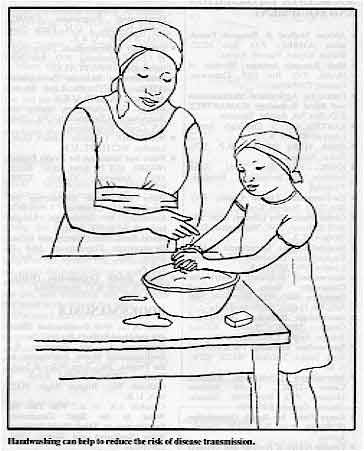 |
Washing, especially hand washing, should be done whenever possible with soap. Where
soap is not available for bathing, substitutes such as ash, clean sand, a flat stone, or a
clean cloth to rub the body, could be used. The importance of handwashing Handwashing after defaecation will greatly help to reduce the risk of disease
transmission. In areas where anal cleansing with water is practised, the promotion of handwashing may
create fewer problems than in areas where other cleansing materials are used. When anal
cleansing is done with water it means that at least some water is available and that
handwashing may be integrated more easily as a part of defaecation practice. DOMESTIC HYGIENE
|
To prevent disease transmission:
- make sure that water containers, dippers and cups are clean to prevent the contamination
of drinking water;
|
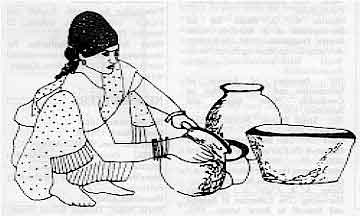 |
- wash cooking pots, dishes, eating utensils, carefully after each use. A rack drainer (to
keep items above the ground) in the sun above a soakaway may be the best place to drain
and dry washed articles. The water from washing can be emptied into the soakaway (waste
water soakage pit);
- control flies not only by burying faeces and use of pit latrines but also by covering
food and safely disposing of domestic waste;
- cover, bury or burn domestic waste to deter flies and rats.
|
|
DDOnline Water
and Sanitation supplement to DD31  3 Page 4 3 Page 4
EXCRETA DISPOSAL Safe excreta disposal is as essential as a safe water supply in preventing the spread
of disease. Where there is no latrine If there is no latrine available, it is important to dispose carefully of faeces by
burying - dig a small hole before passing stools (as far away as possible from houses,
paths, animals and small children, and at least 10 metres away from the water supply), and
cover with earth to prevent contact from flies and animals. Avoid going barefoot to
defaecate, and do not allow children to visit the defaecation area alone. Children and excreta disposal
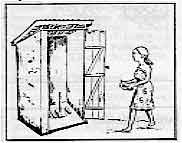 |
A common belief in many societies
is that the faeces of babies and children are less harmful than those of adults. In fact
the faeces of babies and young children are just as dangerous as those of adults. It is
therefore important to dispose of these faeces in a safe way. |
If children are too small, or are too scared of the squat-hole, to use a latrine, a
separate children's latrine could be built or a hole in the ground at a convenient
distance from the house made for them to use for defaecation. After each time it is used
the faeces should be covered with soil. Another hole can be made when the first one is
full. Another possibility is to get the child to use a potty, or to defaecate onto paper
or a large leaf, which can then be put in the latrine. Locating a latrine
|
A latrine should be at least 15 metres from all wells,
springs, rivers, or streams.
- If possible, the bottom of the latrine should be more than 1.5 metres above the highest
groundwater table. If the bottom of the latrine is likely to be close to, or reach down
into, the groundwater, then build it downhill from the water source. If you cannot place
the latrine downhill, then it should be built at least 15 metres away from all houses,
wells, springs, rivers or streams.
|
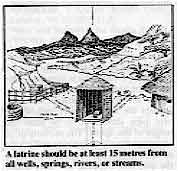 |
- A latrine site should be dry, well drained and above flood level.
- The latrine should be close to the home, if it is too far away, it is less likely to be
used.
|
Choosing a latrine
|
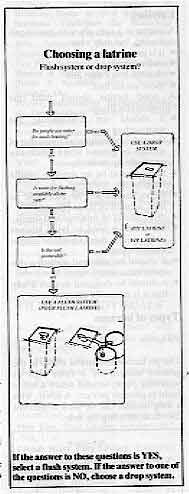
|
Flush
system or drop system?
Do people use water for anal cleaning?
Is water for flushing available all the year?
Is the soil permeable?
If the answer to these questions is YES, select a flush
system - Pour Flush Latrine.
If the answer to one of the questions is NO, choose a drop
system - Pit Latrine or VIP Latrine.
|
LATRINE COMPARISONS
|
| LATRINE |
Rural application |
Urban application |
Cost to build |
Ease of construction |
Water requirement |
Best anal cleaning material |
Hygiene |
Fertilizer production |
| Pit latrine |
suitable in all areas |
not in high density suburbs |
low |
simple-except in wet and rocky ground |
none |
any |
moderate |
can do |
| VIP Latrine |
Suitable in all areas |
not in high density suburbs |
low |
simple-except in wet and rocky ground |
none |
any |
good |
not easily |
| Pour flush latrine |
suitable |
not suitable |
high |
requires skilled builder |
water source near privy |
water |
good |
no |
Water and Sanitation
Health Basics - A supplement to Issue no. 31 December 1987
Page Navigation
This edition of Dialogue on Diarrhoea Online is produced by Rehydration Project. Dialogue on Diarrhoea was published four times a year in English, Chinese, French, Portuguese, Spanish, Tamil,
English/Urdu and Vietnamese and reached more than a quarter of a million readers worldwide. The English edition of Dialogue on Diarrhoea was produced and distributed by Healthlink Worldwide. Healthlink Worldwide is committed to strengthening primary health care and
community-based rehabilitation in the South by maximising the use and impact
of information, providing training and resources, and actively supporting
the capacity building of partner organisations. - ISSN 0950-0235 Reproducing articles
Healthlink Worldwide encourages the reproduction of
articles in this newsletter for non-profit making and educational uses. Please
clearly credit Healthlink Worldwide as the source and, if possible, send us a copy of any uses made of the material.
|
updated: 4 March, 2016
|
version of this Issue
